David Poncelow a 31-years-old computer programmer and scuba diver is battling breast cancer, and he blogs about it in his new blog called What’s up with David?
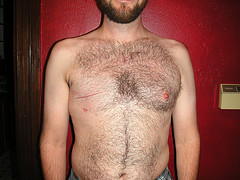
He also started a flickr gallery to show people his before and after procedure pictures.
Medicine as it must be, unlimited
David Poncelow a 31-years-old computer programmer and scuba diver is battling breast cancer, and he blogs about it in his new blog called What’s up with David?

He also started a flickr gallery to show people his before and after procedure pictures.
Well, yesterday was this blog’s first anniversary and what a greater way to celebrate than to be “slashdotted.”
Not exactly slashdotted, but dugg, wired, kevinned, NHSed, Emergiblogged and many more. For all the people who kindly linked to my site, thank you a lot.
![]()
From Shortstats
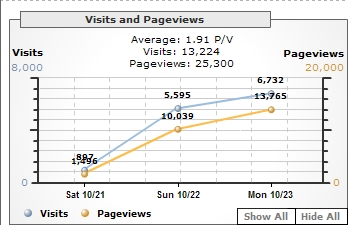
From Google Analytics
With that ammount of traffic, my website crashed for an hour, but everything came back to normal.
I would like to thank all the readers, and specially the commentors because you are the possitive feedback.
Thank you for your kind support and for everything. I will keep blogging for you.
Today is the Doctor’s Day in Mexico. More facts in this earlier post.
Congratulations to all my colleagues.
“Your natural strenghts, those inside of you, will cure their diseases”
Hippocrates
Introduction
Leprosy has a rich history dating to biblical times.
“Leper†is an ancient term used to identify patients with leprosy who were severely stigmatized by the deformity that resulted from Mycobacterium leprae infection.
In the clinical context, the term Hansen’s disease should be used instead of leprosy. Gerhard Henrick Armauer Hansen, a Norwegian physician, discovered the microbe in 1874 just before Koch’s discovery of Mycobacterium tuberculosis.
Epidemiology
In Mexico, in the last 16 years the prevalence of Hansen’s disease has been reduced about 95%, from 16,694 reported cases in 1990 to 820 reported cases in 2006. The World Health Organization (WHO) established the goal of eliminating leprosy as a public health problem by the year 2000, with “elimination” defined as a reduction in prevalence to <1 case per 10,000 population in all endemic countries. The six countries with the highest rates of endemic leprosy in 2001 are: Brazil, India, Madagascar, Mozambique, Myanmar, and Nepal
Transmision
This disease is probably spread by the respiratory route, like tuberculosis.
Risk Factors
Close contact
Older persons
Impaired cell mediated immunity
Clinical manifestations
The cardinal manifestations of leprosy are infiltrative skin lesions, hypoesthesia, and peripheral neuropathy
The clinical manifestations of leprosy are closely related to the polarity of the cellular immune response to M. leprae in the patient.
The history of a patient with suspected leprosy should include whether the person has resided in an area with high prevalence and whether the person has been previously diagnosed or treated for leprosy. Certain patients may deny knowledge of a prior diagnosis or may report that skin lesions or neuropathy or both are acute, as they wish to avoid the stigma of a diagnosis of leprosy, even in emigrants to developed countries.
If lepromatous leprosy is left untreated, it can progress to “leonine†facies as seen in the following images.
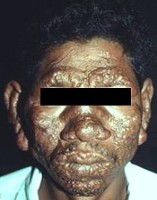
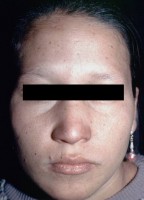
Diagnosis
This includes physical exam and skin biopsy.
Treatment
Once monthly: Rifampin, Dapzone and Clofazimine for two years and then stop.
Daily: Sulfone and Clofazimine for two years and then stop.
Kittiwat Unarrom, a 28-years-old Thai student, bakes human being parts. Just a little detail, this parts are bread sculptures.
He said:
Of course, people were shocked and thought that I was mad when they saw the works. But once they knew the idea behind it, they understood and became interested in the work itself, instead of thinking that I am crazy. Everyone’s life is rushed nowadays, even when it comes to eating.
When we eat, we don’t think about our health or safety, we only think of our taste buds. When people see the bread, they don’t want to eat it. But when they taste it, it’s just normal bread. The lesson is don’t judge just by outer appearances.
Looks amazing to me.
Emergiblog by Kim, is hosting this week’s edition of Grand Rounds.
She has a nice, huge and easy to read edition. With a coffee theme.
You did a great job as usual Kim, and I’m happy that you are not longer using blogger.
I am thankful to be included in your compilation, Kim. Great job.
Israel SarrÃo arrived at the Rehabilitation Center of Levante from Hospital Peset in Valencia (Spain) on January 31st of 2004 with an amputation of the left arm 2 inches above the elbow.
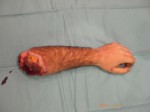
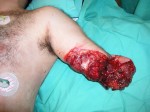

At 14:00hrs, the microsurgery implant began. The first maneuver consisted in lavage and sterilization of the amputated arm and its connection to the brachial artery by a silicone tube in order to revascularize it.
Later we rebuilt the humerus and repaired the brachial artery, the basilic and cephalic veins, and the three nerves of the arm.
This proccess lasted 21 hours, and the reimplantation was successful. The patient went to the Intensive Care Unit during that night and the next day, he went to a normal room.
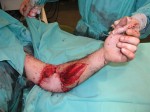
Two days later, we found a wound infection that was seriously compromising the viability of the reimplantation. We talked to the family and they told us that the day of the accident the arm fell in a drain. This contamination was the probable cause of the unfavorable progress. The situation was critical, and we said to the family that there were two different options: reamputate the arm or try to save it by taking it into a healthy zone where it would be possible to nourish it while we cleaned the infected area.
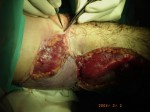
The idea of taking the arm to another anatomical location came by reading a similar case published by Michael Wood (Mayo Clinic, Rochester, MN, USA) in which he attached an arm in the groin. The uniqueness of our case consisted of using the procedure to rescue the limb from an infection, called a Deferred Transitory Heterotopic Implant. This was the first such case of involving an elbow.
With the agreement of the family it was decided to transfer the arm to the groin where large blood vessels are readily accessible. In 4 hours we disassembled the reconstruction performed earlier and connected the blood vessels of the arm to those of groin by means of microsurgery.
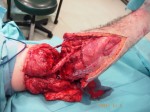
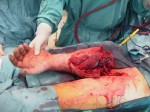
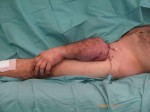

The psychological impact on the patient was very important. As soon as he woke up, we told him that the arm was infected and we have to save it in other location on his body. After a couple of hours he realized that the arm was on his leg. He stayed that way for nine days with daily cleanings until it was verified that the stump was clean.
On February 12nd of 2004, we reimplanted the arm in its original place, rebuilding bone, arteries, veins, nerves, muscles and skin in a procedure of 6 hours.
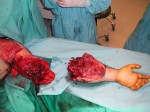
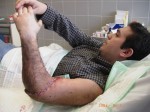
Afterwards, the patient was doing physically and psychologically well, happy that he have not have to lose his arm.
By this time the patient could move his elbow. From the time of the surgery, the repaired nerve functionality is growing at a speed of 1 milimeter per day. In about 6 months we hope that he will be able to move his hand and fingers.
The function which we hoped to obtain from this procedure was better than those obtained with an amputation and the prosthesis. The patient will be able to grasp objects, to perform normal life functions, such as tie his shoes, all with small orthopedic aids.
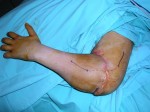
The complete surgical team of the Unit of Hand and Reconstructive Surgery was involved in this operation, with Dr. Pedro Cavadas leading the team, and Dr. Navarro, Dr. Soler, Dr. Duke and Dr. Landin as assistants.
A new surgical retractor that is useful in three different kinds of surgeries, will be used in 171 countries and it was developed by Angel Raul Soriano Sanchez (Mexican Ob/Gyn from the National Institute for Social Security – IMSS), was international patented.
This new surgical retractor for abdominal or vaginal surgery and can be used in gynecologic, obstetric and vaginal surgeries.
“This surgical retractor replaces the others, because its use reduces a half of time in a procedure; reduces the bleeding and hospital stay”, said its inventor.
This retractor allows better visibility and a greater space to work.
I’ll try to obtain a picture of this instrument.
I always enjoy the Image Challenge Contest at The New England Journal of Medicine, time ago there was a similar picture of this:
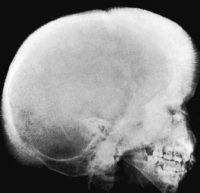
U P D A T E: A nice comment and correct answer by Drmikeunoe
We can see generalized osteopenia, widening of the diploetic space, and thinning of the outer table.
This characteristic “hair on end†appearance of the outer table is compatible with the presence of massive hyperplasia of the bone marrow, as can be seen in the homozygous state of beta-thalassemia (i.e. thalassemia major).
Beta thalassemia syndromes are a group of hereditary disorders characterized by a genetic deficiency in the synthesis of beta-globin chains (adult hemoglobin usually is α2β2) resulting in excess α-chains and severe transfusion-dependent anemia, thus causing bone marrow hyperplasia.
Welcome to the 3.3 edition of Grand Rounds 3.3. The theme of this edition is the classic table of contents of many medical journals. I hope someday, Grand Rounds editions are also available as an in-printed version.
Sid Schwab has a touching story about how the beginning of surgery should be. It’s an attempt to convey the feeling of making a surgical incision, called Taking Trust.
Clinical Cases and Images points something I’ve been thinking for a while: In the future, Web 2.0 projects may have a similar value to printed manuscripts, and he thinks that maybe in the future any academic appointment will have a section of “What are your internet projects?” This may sound kind of crazy until you realize that some medical blogs have more readers than some lesser known medical journals.
Enrico writes a nice story about the unexpected academic situations he’d find himself in going to school in Mexico, and the stress that comes with training in one country with different educational philosophies.
Dr. Charles wrote a story about refusing to lie, so that an elderly patient can keep the keys to a 1936 Dodge two door sedan, and their freedom.
Borneo Breezes tells the experience of a Pakistani Non-Governmental-Organization in responding to the earthquake back in October 8th, 2005.
Dr. Nic has a good dilemma on code status. To be resucitated/intubated or not to be resucitated/intubated (DNR alone, DNI alone, DNR/DNI).
Transplant Coordinator from Donor Cycle writes with a great sense of humor about what it takes to be a transplant coordinator.
Dr. Emer gives us a nice reason why isn’t only women who ought to be labeled as shopaholics in Compulsive Shopping in Men.
Doctor Anonymous explains what he feels during fall where flu shots are given as candies. He calls it: Flu shot fiasco.
Enoch Choi reviews new recalls of contaminated food: E. coli tainted lettuce and ground beef.
Wandering Visitor wrote a post about the War Against Fat which summarizes a recent study in the Journal of Neurology about the association between a high fat diet (and copper) and Alzheimer’s disease.
What do you think about Yupik eskimo people? TundraPA says that “they are very inventive at problem solving“, and she wrote about a health aide teaches a patient how to use an MDI with a homemade spacer.
Dr. Kavokin at RDoctor makes a brief review of head injuries and you can take a quiz to learn more.
Paul Auerbach describes what are minor head injuries according to Glasgow Coma Scale.
Steven F. Palter introduces his vision of hand “gesture controlled” surgery.
Dr. Bard Parker writes about responsibilities assumed by physician extenders and lack of communication between physicians.
Dr. Deborah Serani blogs about the World Mental Health Day. This year’s theme is “Building Awareness – Reducing Risks: Mental Illness and Suicide”
Kim -the 51% nurse and multiple host of blog carnivals- blog about the evolution of how making nurse reports has changed to mean significantly and this supposes an additional work.
PaedsRN from Mediblogopathy talks about a big responsibility and answers the questions, What’s life support? and Why are nurses running it?
Mother Jones RN tell us a story about her day as a charge nurse on a psych unit where a patient thinks the devil wears a hospital ID badge and the devil doesn’t always wear Prada
Karen, a last year South African student in her brand new blog, writes a stirring story about an encounter she had in casualties with a man who had been severely neglected by his family, called Love Thy Father.
Laurie, from A Chronic Dose gives a special meaning and hope to the marriage where chronic illness is present. She reminds us that human beings aren’t numbers, and We can beat statistics.
Amy, publisher of Diabetes Mine, perfectly explains to us her point of view (from the patient perspective) about marketing wars around new continuous glucose monitoring, it’s really a DogFight.
Difficult Patient writes about domestic violence/abuse: a little bit on his own experience, legal definitions, signs to look for, what to do, and assessing whether a batterer will kill.
Emily DeVoto has an excellent point of view about how to improve healthcare quality. Indeed it is important to map genes of the mouse brain, but it is more important to improve the conditions of healthcare quality.
Tony Chen, at Hospital Impact gives us the top nine most important healthcare issues that no one’s talking about.
Bob Vineyard writes what all we know, but we never say anything about it; and he shreds a report that doctors treat patients who lack health insurance differently than patients who are insured.
ImpactEDnurse comes with some basic guidelines for keeping you and your patients out of harms way during a pandemic. This is something of which all the involved people in the Health Care, should know.
Aetiology by Tara C. Smith discusses about three new vaccines and how by vaccinating pregnant women, newborns are protected from influenza; an upcoming vaccine for non-typeable Haemphilus influenzae; and the sad state of polio vaccination (and fear thereof) in Nigeria.
Hsien-Hsien Lei comes with a funny story where Robert DeNiro takes care of your heart and he really worries about your health and also, Hsien tells you fast facts of fat.
Bob Coffield takes on the important question raised by Tony: Is it healthcare or Health Care?. I will update my earlier posts.
Susan Palwick a volunteer ER chaplain, wrote an interesting post about feelings and emotions of health care personnel when patients are also friends.
With these thirty entries, I conclude this week’s Grand Rounds. I would like to thank to Nicholas Genes, the conceiver of this linkfest, and all who contribute in submissions and those who stop by reading this.
Next week’s Grand Rounds will be hosted by Kim (the woman who never sleeps) at Emergiblog.